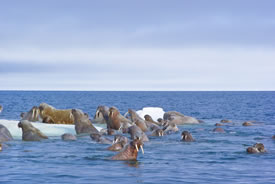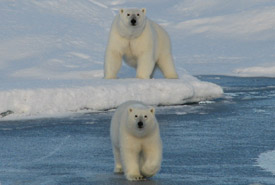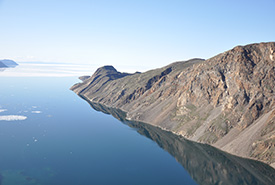Canada's Arctic 101

Walruses, Lancaster Sound (Photo by Mario Cyr)
Canada’s Arctic extends from the tree line, through the Arctic Archipelago to the North Pole. It is a vast, diverse ecosystem that is unfamiliar to most Canadians. Habitats include expansive plains, rugged coasts, glaciers and high mountains.
Why NCC protects this habitat
There is nowhere on the planet quite like the Arctic. It is a place of uncommon beauty and natural richness.

Polar bear mother and cub, Jones Sound, Nunavut (Photo by NCC)
Many parts of the Arctic support a high variety and abundance of large mammals, including polar bear, muskox and caribou. The Arctic also has a diversity of whales and seals, and supports millions of seabirds, shorebirds and waterfowl.
Conservation needs
Over the past 50 years, the amount of summer sea ice in the Arctic has decreased by almost seven per cent each decade. This loss impacts the marine ecosystem in a number of ways, including increasing water temperatures and reducing areas where seals and walruses can rest. A warming Arctic sea will also open up this region to increased shipping and expand opportunities for resource extraction.
Tallurutiup Imanga/Lancaster Sound

Inlet around Lancaster Sound, NU © Parks Canada/Diane Blanchard
Habitats in this region include polynas, which are large areas of open water surrounded on all sides by sea ice. Polynas are critical feeding areas for many marine mammals, including harp and ringed seal, narwhal, beluga and bowhead whales, walrus and polar bear. The Arctic Ocean’s surrounding islands and coasts are important nesting habitat for seabirds.
Five facts about the Arctic region
1. Fifty per cent of Canada’s population in this area consists of Indigenous communities.
2. Water is the Arctic’s largest resource. This region holds about 20 per cent of the Earth’s fresh water in the form of ice.
3. Whales that live here year-round include beluga and bowhead, with humpback, grey and killer whales visiting only in the summer.
4. The Arctic has been described by scientists as the canary in the coal mine in terms of the impacts of global warming, as this area has been greatly impacted by rising temperatures.
5. Several species at risk that depend on the Arctic landscape for survival, including beluga whale, polar bear, narwhal and ivory gull.




